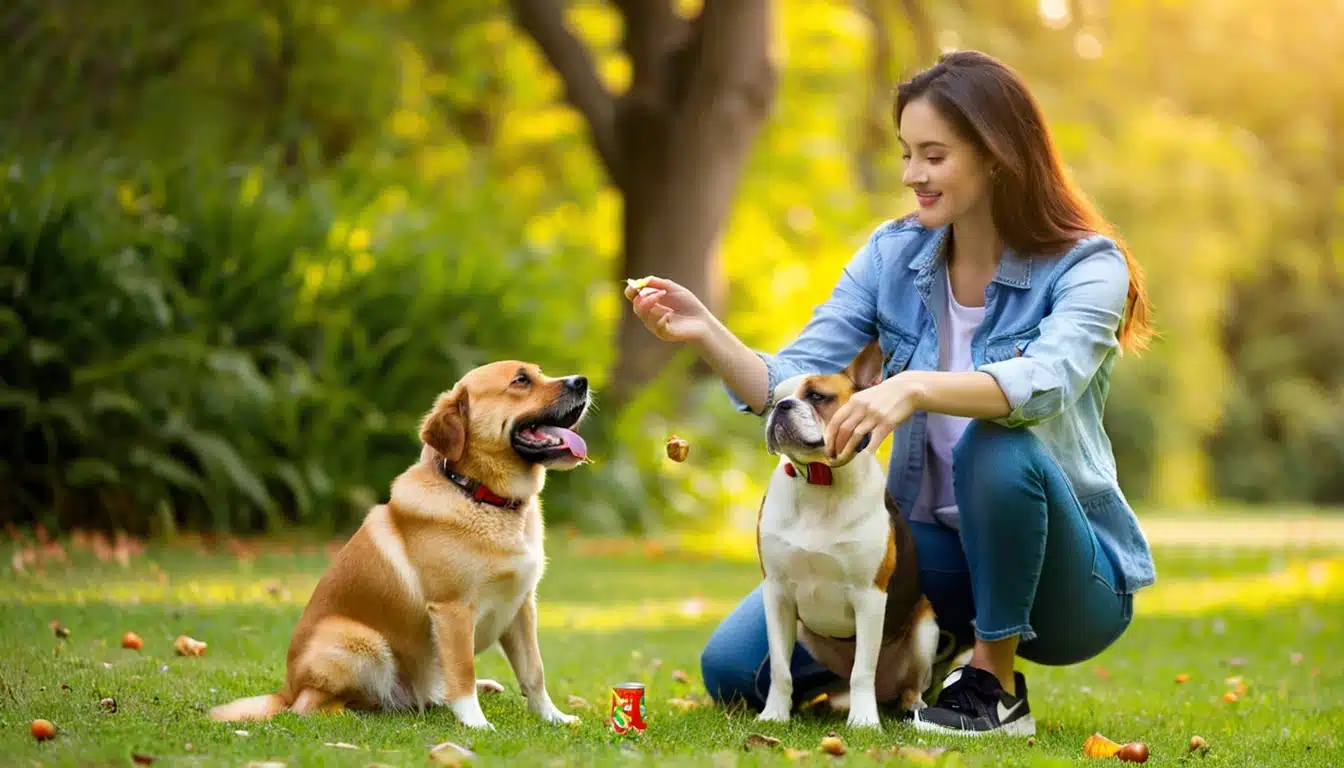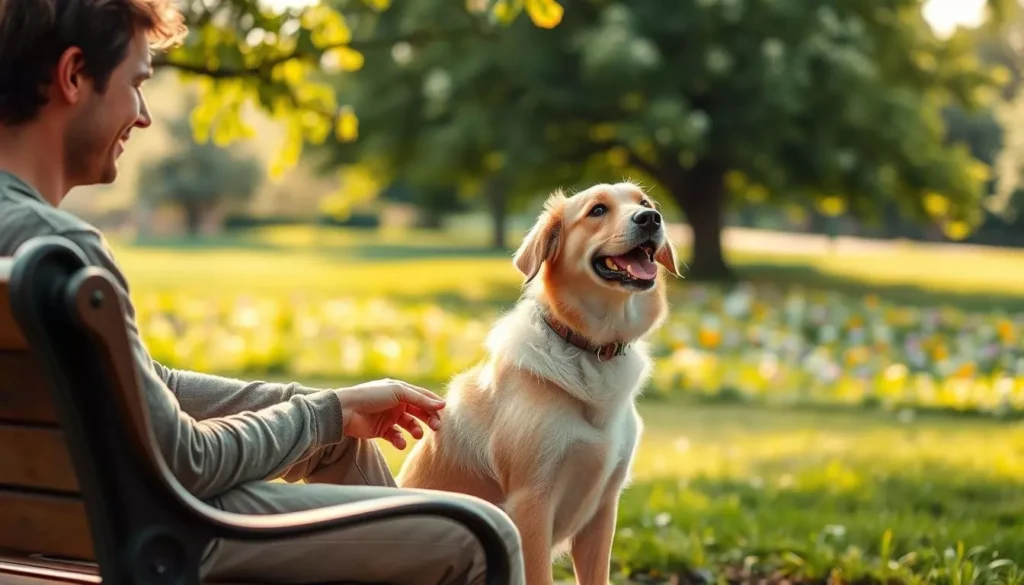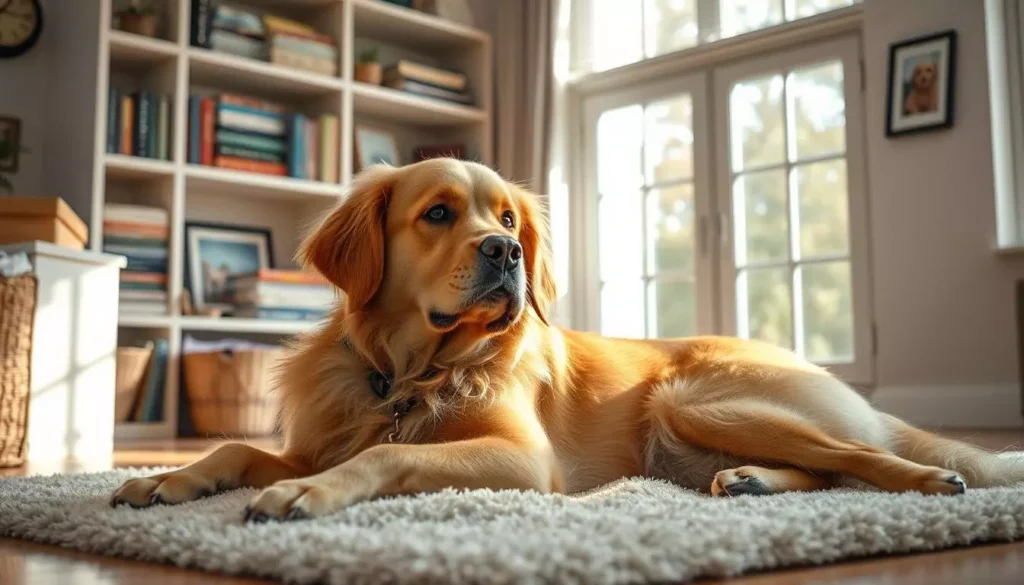Getting a new dog is more than just adding a pet to your family. It's a journey filled with joy, challenges, and deep connections. When I first started training my dog, I felt a huge sense of responsibility. I wondered, "How do I start training my dog?" It seemed tough at first, but I soon realized each command was a step towards a stronger bond.
Starting early with dog training is key. It helps in teaching good behavior and builds a loving environment. In this guide, I'll share my experiences and tips on starting dog training. We'll focus on positive reinforcement and essential commands for a lifelong partnership.
Key Takeaways
- Understanding that early training is crucial for a well-behaved dog.
- Using positive reinforcement to create a positive learning environment.
- Establishing basic obedience commands as the foundation.
- Recognizing the emotional bond that develops through training.
- Remaining patient and consistent is key to successful training.
Understanding the Importance of Dog Training
Dog training is key to having a well-behaved pet. It makes sure both the dog and its owner are safe. Knowing how to train a dog is essential for a happy home.
Benefits of Training Your Dog
Training a dog has many benefits. A trained dog can go on adventures without a leash. This keeps the owner in control. It also stops bad behavior by keeping the dog's mind busy.
Training helps improve behavior for good. It makes for a healthier life for both the dog and the owner.
Building a Stronger Bond with Your Canine
Training is more than just teaching tricks. It strengthens the bond between you and your dog. Trust and communication grow with each training session.
Regular training makes your relationship better. Both you and your dog will feel safe and connected.
When to Start Training a Dog
Training a dog can start as soon as you bring your new puppy home. It's important to know when to start, as puppies learn best from eight weeks old. At this age, they are very open to learning new things.
Starting Young: Ideal Age for Training
I always suggest starting with basic commands and socialization right away. Early training focuses on simple commands like “sit” and “stay.” These commands are the foundation for future learning. Being consistent and using positive reinforcement works best at this age.
As your puppy grows, you can add more complex commands to their training.
Can I Start Training an Older Dog?
It's never too late to train your dog. Many people ask how to start training an older dog. Older dogs might take a bit longer to learn, but they can still benefit from training.
When training older dogs, it's important to be gentle and patient. Positive reinforcement is especially effective and rewarding for both of you.
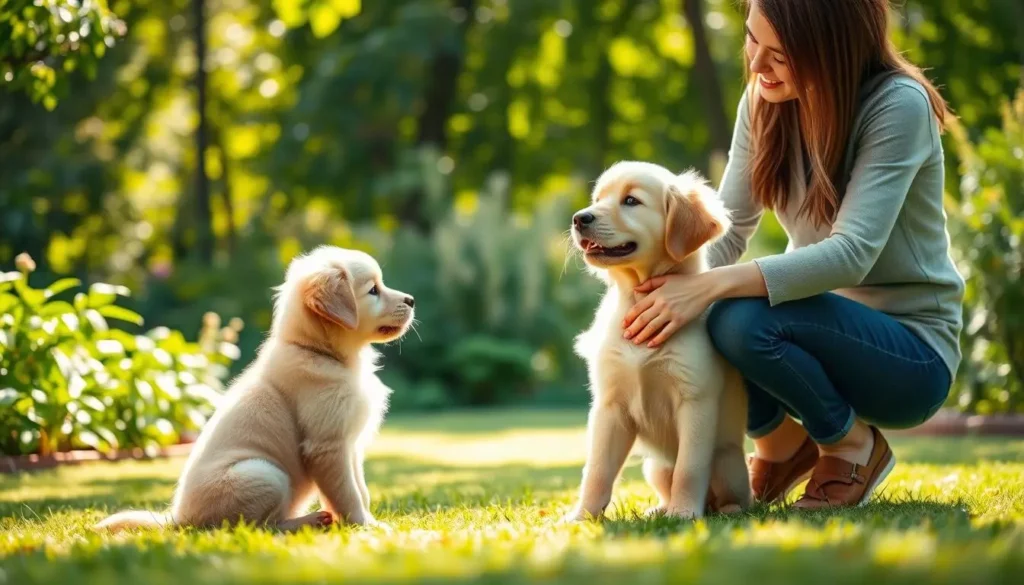
How to Start Training a New Dog
Starting to train a new dog can seem tough, but it's rewarding with positive reinforcement. This method encourages good behavior by giving rewards. It's key to start strong, especially for herding dogs. Learn essential commands that help both the dog and handler.
Building a Foundation with Positive Reinforcement
At first, I saw how positive reinforcement works. It motivates the dog and strengthens our bond. Rewarding my dog with treats and praise for good behavior makes learning fun.
This is true for any new dog. Keep training sessions fun and engaging.
Essential Commands for Beginners
Every training program needs basic commands. I started with simple ones to build a solid base. Here are some must-know commands for beginners:
- Sit: Teaches your dog to sit on command.
- Stay: Helps the dog understand to remain in place.
- Come: Important for recall, ensuring your dog returns to you.
- Down: Encourages your dog to lie down, a versatile command.
- Leave it: Teaches the dog to ignore distractions or unwanted items.
These commands are the foundation for more complex training. Whether training a new dog or a herding dog, be consistent. Short, frequent practice sessions help your dog learn without getting stressed.
Start Training Dog: The Basics of Obedience
When I start training my dog, I focus on the basics of obedience. These skills help my dog behave well and keep everyone safe. Teaching them commands like "sit," "stay," and "come" helps them listen and understand me better.
Key Commands: Sit, Stay, Come
The most important commands are the foundation of a well-behaved dog. Each command has a specific purpose that helps with obedience. Here's a quick overview of these essential commands:
| Command | Purpose | How to Teach |
|---|---|---|
| Sit | Teaches self-control and calms the dog. | Hold a treat above their head and move it back, encouraging them to sit. |
| Stay | Prevents the dog from moving until released. | Ask them to sit, then step back while saying "stay." |
| Come | Calls the dog back to me for safety and obedience. | Use a treat to lure them, saying "come" enthusiastically. |
Using Signals and Cues
Using both verbal commands and hand signals helps my dog understand better. Hand signals give them a visual clue that goes with what I say. For example, raising my hand means "stay," and pointing down means "sit." This mix makes them more reliable at home and out in public.
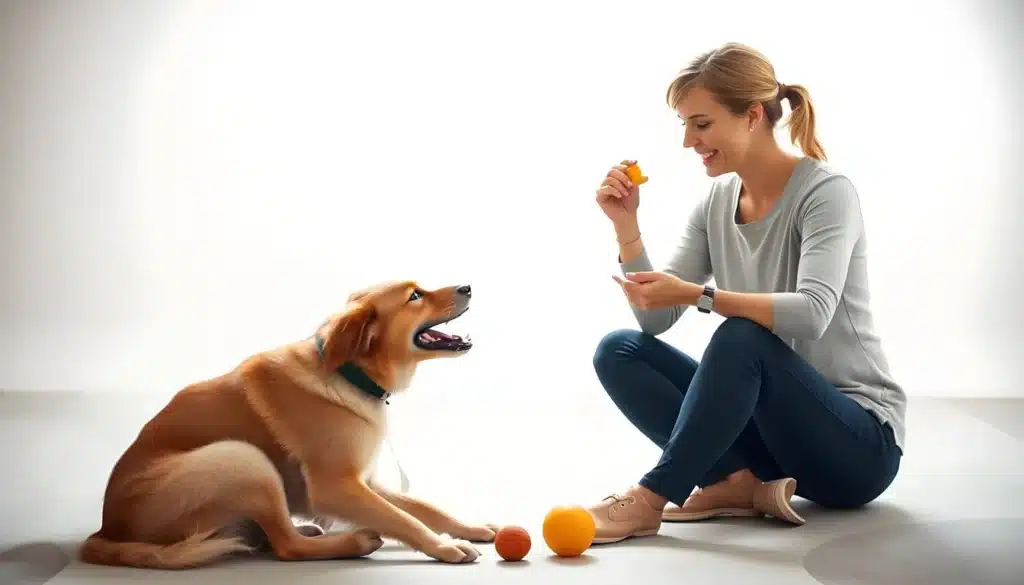
Choosing Dog Training Supplies
Choosing the right dog training supplies is key for effective training. Knowing what equipment you need can greatly improve your dog's training results. When training a bad dog, the right tools make a big difference.
Essential Equipment for Training Sessions
There are several key items you need for training. Here are some essential supplies:
- Collars: A sturdy collar is crucial for connecting with my dog during walks and commands.
- Leashes: A quality leash allows for control and safety during training exercises.
- Clickers: Clickers can reinforce positive behaviors efficiently, marking the desired action as it happens.
- Treat bags: Having treats handy helps me reward my dog promptly and effectively.
- Training pads: Useful for younger dogs during house training, these pads help prevent accidents.
Top Ten Must-Have Training Tools
Here’s a detailed look at the top training tools that enhance not only your control but also your dog's learning experience:
| Tool | Purpose | Benefits |
|---|---|---|
| Collar | Identification and control | Safety and ease of use during training |
| Leash | Walking and control | Prevents distractions and escape |
| Clicker | Positive reinforcement | Clarifies which behavior is being rewarded |
| Treat Bag | Rewarding good behavior | Quick access to rewards increases effectiveness |
| Training Pads | House training aid | Makes cleaning easier and reinforces habits |
| Dog Crate | Safe space for the dog | Helps with crate training and offers security |
| Interactive Toys | Mental stimulation | Keeps the dog occupied and prevents boredom |
| Training Clicker App | Digital clicker functionality | Convenience for on-the-go training |
| Measuring Cups | Portion control for treats | Maintains healthy weight while training |
| Hand Signals Guide | Visual cues for commands | Aids in teaching dogs non-verbal commands |
Positive Reinforcement Techniques
Understanding how to train my dog is key. Positive reinforcement is vital in teaching good behavior. By rewarding my dog for good actions, I create a positive learning space. This encourages my dog to be more engaged and excited.
There are many rewards I can use, each suited to my dog's likes. These rewards help make training fun and effective.
Understanding the Role of Rewards
Knowing what motivates my dog is crucial for positive reinforcement. It could be a tasty treat, a favorite toy, or a kind word. Identifying these motivators greatly improves training results.
Using different rewards keeps my dog interested. It also strengthens their learning, making training sessions both fun and productive.
Types of Rewards: Treats, Toys, and Praise
There are many rewards I can use for positive reinforcement:
- Treats: Small, tasty treats are very effective for training. They should be something my dog really enjoys.
- Toys: Using toys as rewards makes training feel like play. It links fun with learning.
- Praise: Kind words and affection are strong motivators. They strengthen our bond and reward good behavior.
How to Create a Training Schedule
Creating a structured training schedule is key for effective dog learning. Short, focused sessions are more effective over time. Knowing how long a dog training session should last is crucial for keeping my dog engaged.
Determining Training Session Length
For dog training sessions, I find five to ten minutes works best. Younger dogs have short attention spans. Brief sessions help reinforce good behavior and prevent frustration.
After a successful session, I take a short break. This keeps training exciting and fresh for my dog.
Regular vs. Sporadic Training
Regular training leads to better obedience in my dog. Consistency helps my dog know when training times are. Sporadic training can confuse and reduce learning retention.
Training daily or several times a week, even for short periods, keeps my dog motivated. This keeps progress on track.
Crate Training Your Dog
Crate training is key for pet owners wanting a well-behaved dog. It creates a safe space for your dog and helps with potty training. Knowing the crate training benefits makes the process easier and more effective.
Benefits of Crate Training
Crate training has many benefits. A crate becomes a safe haven for your dog, making them feel secure and relaxed. It helps reduce anxiety in new places. It also helps with potty training, making life easier for you and your dog.
Dogs learn to see the crate as a place of comfort and safety. This leads to a more confident and well-adjusted pet.
Steps to Crate Train Your Dog Successfully
Starting crate training is easy if done right. Here's how to begin training a new dog:
- Introduce the crate slowly. Let your dog explore it without pressure.
- Use positive reinforcement. Reward your dog with treats or praise when they go into the crate on their own.
- Start with short periods in the crate. Gradually increase the time as they get more comfortable.
- Make sure the crate is always a positive place. Don't use it as punishment.
- Be consistent. Keep up the routine to show them the crate is a safe space.
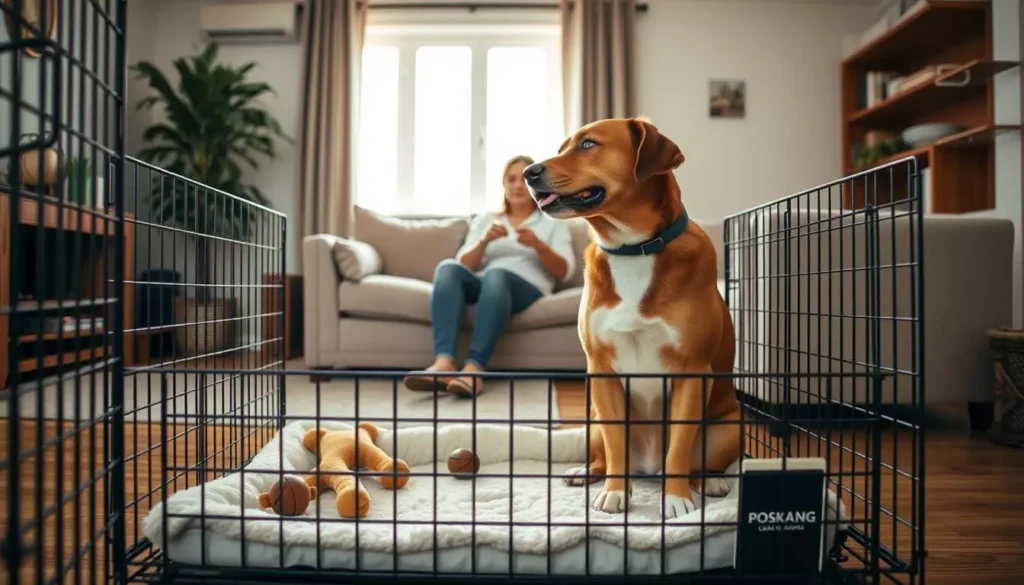
Potty Training Fundamentals
Potty training is key for responsible dog ownership. It helps your dog behave well. This process can take weeks to a month. It needs constant supervision and regular breaks.
Using a systematic approach helps create good habits. These habits are important for the future.
How to Housetrain Your Dog
Success in housetraining comes from a routine. Taking your dog out often, especially after meals and naps, helps a lot. Here are some steps to follow:
- Set a regular schedule for potty breaks.
- Watch for signs that your dog needs to go outside.
- Choose a specific area for potty breaks for consistency.
- Give your dog a treat right after they go outside.
Positive reinforcement makes your dog associate going outside with good things. Clear communication makes learning easier for them.
Common Potty Training Mistakes to Avoid
Many dog owners make mistakes that slow down potty training. Ignoring your dog's signals can lead to accidents. Here are some mistakes to avoid:
- Not rewarding your dog for successful potty breaks.
- Missing early signs that your dog needs to go outside.
- Being inconsistent with the training schedule.
- Using punishment for accidents instead of rewarding good behavior.
Knowing these mistakes helps you focus on positive habits. Patience and hard work are crucial during this time.
Socializing Your Dog
Socializing your dog is key to raising a happy pet. It helps them get used to different places, people, and animals. This can stop fear and anxiety, making your dog happier and more confident.
The Importance of Introducing New Experiences
Every dog needs new experiences. These help them be more friendly and adaptable. Without them, dogs might become scared of strangers or aggressive to other pets. Introducing your dog to new things helps build their confidence and good behavior.
Techniques for Effective Socialization
There are many ways to socialize your dog well. Slow introductions are good, letting them meet new things at their own pace. Positive rewards like treats or praise help them see new things as good. Being consistent and patient helps your dog become open and friendly.
| Technique | Description | Benefits |
|---|---|---|
| Gradual Introductions | Slowly expose your dog to new experiences. | Promotes comfort and reduces anxiety. |
| Positive Reinforcement | Reward your dog for encountering new situations positively. | Builds confidence and encourages repeat behavior. |
| Group Classes | Join a training class with other dogs and owners. | Enhances social skills and provides structured learning. |
| Playdates | Arrange play sessions with friendly, well-socialized dogs. | Teaches appropriate play behavior and social interaction. |
Using these socializing techniques can make your dog more adaptable and confident. Spending time on socialization can really improve your dog's behavior and happiness.
Addressing Behavioral Issues During Training
Training my dog came with its share of behavioral challenges. Issues like excessive barking, biting, and jumping made things tough. It's key to understand why these behaviors happen.
By knowing the root cause, I could tackle each problem head-on. Sometimes, simple fixes weren't enough. That's when I needed more structured methods.
Common Problems: Biting, Barking, Jumping
Biting, barking, and jumping were big hurdles for me. These issues often come from anxiety, excitement, or poor socialization. A steady training plan helped a lot.
For example, playing with my dog to redirect their energy cut down on jumping. Learning specific techniques for each issue was crucial for lasting success.
Working with a Professional Trainer
When my dog's behavior didn't improve, a professional trainer was a game-changer. They knew all about behavioral training and offered custom solutions. Their help not only boosted my training but also deepened my understanding of my dog's needs.
Getting a trainer was a smart move. It laid a strong foundation for solving common dog behavior problems.
Training Commands and Tricks
Training commands and tricks are great for bonding with my dog. They make our time together more fun and meaningful. Teaching tricks like "roll over" or "play dead" boosts my dog's confidence and keeps their mind sharp.
Basic Tricks Every Dog Should Know
Basic tricks are essential. They help build a strong foundation for more complex commands. Here are some key tricks every dog should learn:
- Shake hands
- Spin in circles
- High five
- Play bow
These tricks are not only fun but also strengthen our bond. They help build trust and teamwork between us.
Advanced Training Techniques to Try
When my dog knows the basics, we move on to advanced techniques. Activities like scent detection, agility training, or advanced obedience commands are great. They keep my dog physically and mentally active.
Combining basic tricks with advanced techniques makes our training sessions fun and rewarding. It ensures we both enjoy and benefit from our time together.
Conclusion
Reflecting on dog training, I see it's more than just teaching commands. It's a lifelong journey that needs patience, consistency, and a positive attitude. Starting early and using different techniques helps me raise a well-behaved and happy dog.
Enjoying the journey and celebrating small wins is key. Each command and milestone we reach strengthens our bond. Keeping a positive attitude helps my dog feel secure and eager to learn.
Whether starting or improving, the most crucial thing is our relationship. Using fun and engaging methods makes training enjoyable and productive. This way, we can have a well-trained and loving friend for many years.

